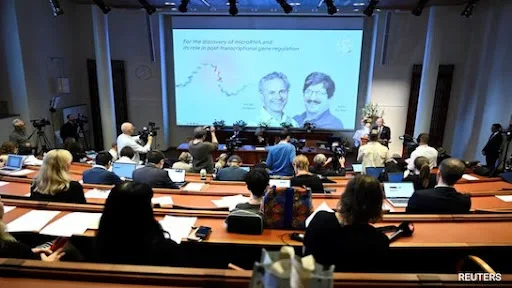Explained: The Discovery of microRNA and Its Potential Impact on Medicine
The 2024 Nobel Prize in Medicine was awarded to two distinguished American scientists, Victor Ambros and Gary Ruvkun, for their groundbreaking discovery of microRNA. This discovery unveiled a previously unknown mechanism of genetic regulation, which holds the promise of unlocking new pathways in medicine, particularly in the treatment of diseases such as cancer, heart conditions, and viral infections. Despite the significant potential of microRNA, it has taken decades for its importance to be recognized within the scientific community. Today, microRNA is seen as a critical player in understanding gene regulation and disease, but the journey to this realization was far from straightforward.
What is microRNA?
At the core of human biology is DNA, the blueprint that dictates how each of our cells should function. Although every cell contains the same set of instructions (DNA), they develop into distinct types, such as brain or muscle cells. This differentiation process is guided by gene regulation, which determines which parts of the DNA's instructions are activated in any given cell. Typically, ribonucleic acid (RNA) plays a key role in this process by acting as a messenger that transmits DNA instructions to proteins, which are essential for cell development.
However, the discovery by Ambros and Ruvkun introduced a new dimension to this understanding. They identified microRNA, a small genetic regulator that functions differently from traditional messenger RNA (mRNA). Rather than carrying instructions, microRNA acts as a switch, turning specific genes on or off. This adds an extra layer of control over gene expression, one that was previously overlooked.
Cambridge University geneticist Eric Miska, who has collaborated with the Nobel laureates, described this discovery as "a whole new level of control" that revolutionized how scientists view gene regulation. By revealing that regions once thought to be non-coding in DNA actually play a pivotal role in controlling gene activity, microRNA has reshaped our understanding of genetic processes.
How was microRNA discovered?
The discovery of microRNA dates back to the 1980s when Ambros and Ruvkun were conducting separate research on the interaction of genes in roundworms (C. elegans). These tiny worms, just one millimeter long, became the unlikely focal point of a major scientific breakthrough. In 1993, Ambros published a paper detailing the discovery of microRNA, though it initially attracted little attention. At the time, many in the scientific community believed that this mechanism was unique to worms and had no broader relevance.
This perception changed in 2000 when Ruvkun demonstrated that microRNA was not confined to worms but was present throughout the animal kingdom, including humans. This revelation underscored the universality of microRNA and its critical role in the development and function of all animals and plants.
According to Miska, this finding shifted the narrative: "This was not just something weird that worms do, but in fact all animals and plants are totally dependent on microRNAs for development and normal function." Since then, scientists have identified more than a thousand human genes that are regulated by microRNAs.
What is the potential impact of microRNA?
The discovery of microRNA has opened the door to numerous potential medical applications, particularly in the fight against diseases like cancer. One of the most promising aspects of microRNA is its ability to function as a tumor suppressor. Some microRNAs act as brakes on cell division, preventing the uncontrolled growth of cells that can lead to cancer. Others, however, can promote cell division, which can result in tumor formation. Understanding these dual roles is key to developing targeted therapies that leverage microRNA for cancer treatment.
MicroRNA is also being studied for its role in viral infections. Many viruses, including hepatitis C, utilize microRNA in their life cycles. As a result, several antiviral drugs targeting microRNA are in various stages of development. While none of these treatments have yet reached widespread clinical use, they represent a promising avenue for future medical breakthroughs.
In addition to treatments, microRNA holds potential as a diagnostic tool. Researchers are exploring its use as a "biomarker" to identify specific types of cancer. For example, a blood test could detect the presence of certain microRNAs associated with a particular form of cancer, aiding in early diagnosis and personalized treatment plans.
Challenges and Future Research
Despite the excitement surrounding microRNA, there are still significant hurdles to overcome before it can be widely applied in clinical settings. One of the main challenges is the instability of microRNAs, which makes them difficult to manipulate for therapeutic purposes. However, scientists remain optimistic that these challenges can be addressed through ongoing research.
Looking ahead, researchers are particularly interested in exploring the role of microRNA in human evolution. Eric Miska believes that microRNAs may hold the key to understanding why the human brain is so distinct from that of other primates. Although human brains are notoriously difficult to study, future research may uncover the specific microRNAs responsible for this unique development, offering insights into the evolutionary processes that shaped our species.
Benoit Ballester, a French researcher, also emphasizes that understanding the complex regulatory networks of microRNAs is crucial. While practical applications may not yet be fully realized, the knowledge gained from studying microRNA is a critical first step in harnessing its potential for medical advancements.
Conclusion
The discovery of microRNA has revolutionized the field of genetics, revealing an additional layer of gene regulation that was previously unknown. While its significance was initially underestimated, microRNA is now recognized as a fundamental mechanism that governs the development and function of all living organisms. The work of Victor Ambros and Gary Ruvkun has opened new possibilities for medical research, particularly in the areas of cancer treatment and viral infections. As scientists continue to explore the potential of microRNA, it is likely that we will see more breakthroughs in the years to come, paving the way for innovative treatments and a deeper understanding of human biology.

Comments